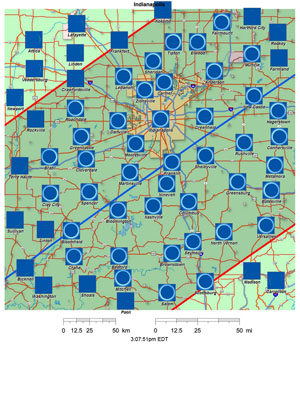The 2024 eclipse in Park, Indiana, USA
39.0162N, 86.8494W
A rough animation of what the 2024 eclipse will look like from Park.
(In this view, the top of the frame is always "up", toward the highest point in the sky.)
What will the 2024 eclipse look like from Park?

Map of Park and vicinity
Current Weather Forecast for Park
CURRENT CLOUD COVER:
LOCAL | NATIONAL
Visit our "Weather" links above for other great cloud cover forecast maps!
Xavier Jubier's Interactive Map for Park
All eclipse circumstances have been calculated for each city using that city's latitude and longitude as sourced from public records. Eclipse2024.org has taken all reasonable measures to ensure the accuracy of the latitude and longitude shown; however, the user of any eclipse information on the Eclipse2024.org site should verify that these coordinates are correct for the intended viewing location. You can do this using web tools such as Google, latlong.net, lat-long.com or gps-coordinates.net. Please let us know if you believe the coordinates need to be updated for any city in our database.
The eclipse in Park will be TOTAL, and we’ve calculated the local circumstances (using the lat/long noted above and ΔT=69.2s), as follows:
| City | Lat | Long | C1 (EDT (GMT-4)) | V | C2 (EDT (GMT-4)) | Duration | Alt | Az |
|---|---|---|---|---|---|---|---|---|
Park |
39.0162N |
86.8494W |
13:48:29 |
04:30 |
15:04:14 |
4m 3.2s |
54° |
214° |
View the instructions for the values shown in the table
In this table, we’ve listed the following information:
Location identifier and latitude/longitude
The times in the table have been calculated based on this exact location. Times can shift by several seconds as you get several miles/km away from the location shown.
Start time of the partial phase ("C1")
All times are given in local time or Universal time [UT] (also known as GMT or Zulu time). You can convert the entire table by clicking on the time zone you want to see it shown in!
Where to look for that first “bite” of partial eclipse ("V")
We’ve called this value “V”, because that’s what astronomers call it. If you imagine the Sun’s disk as a clock face, this is the hour hand value of where to look on that “clock” to see that very first little bite that the Moon is taking! (Remember, you must use eclipse glasses to look at the Sun at this time!)
Who will be the first to see that bite and shout “First Contact!”?
Start time of totality ("C2")
This is what you came here to see! When does totality start? Again, this time is given in Universal time [UT] and you can convert it if you like.
Remember, due to edge effects unique to your viewing location, this time may be “off” by a few seconds, and different observers will see things differently. Therefore, you have to remember the most important safety rule: Use your eclipse glasses to view the eclipse at all times until the very last bit of the Sun’s bright disk has been covered by the Moon! When you can’t see anything through the eclipse glasses any longer, then it is safe to look! (But put them back on IMMEDIATELY as soon as totality is over!)
Duration of totality
How long totality will last – given in minutes and seconds, or just seconds if the location is close to the edge of the path. This is an approximate time, again due to localized edge effects. It is correct to within a very few seconds, though!
Altitude and azimuth of the Sun at the time of totality
This will let you know where the Sun will be in the sky during totality, so you can check to make sure that trees, buildings or mountains won’t be in your way. (You can also go outside to your planned viewing location on the day before the eclipse at eclipse time and check it out yourself. The Sun’s location in the sky at that time won’t change enough in one day for you to notice the difference.)
Altitude is given in degrees. The horizon is at 0°, and straight up is 90°. So 45° would be exactly halfway up, 30° would be 1/3 of the way up, and 60° would be 2/3 of the way up. Anything in between is, well, in between!
Azimuth is given as an angle so you can tell exactly where the Sun will be, and here are some references: 90° is due east, 180° is due south, and 270° is due west. So, if you see 200°, that’s a bit less than 1/3 of the way from due south to due west. 135° would be straight southeast.
Here are some helpful links to let you research the total eclipse as it will be seen from Park:
The Park community page
A page of information about the plans that Park officials are putting in place for eclipse day!
Also includes links to weather and an Interactive Google Map.
What will the 2024 eclipse look like from Park?
Opens the amazing, full-featured eclipse2024.org eclipse simulator, to show you exactly what the eclipse will look like!
(If this is your first visit, you’ll want to open the Eclipse2024.org Eclipse Simulator Instruction page first!)
See all the great FREE resources we've put together for educators, media, and community leaders in Park
Detailed 2024 eclipse viewing information for regions that include Park
We've written some very detailed information about viewing the 2024 eclipse from the area surrounding Park.
You'll be able to find out when and where the eclipse will happen, and see animated maps of the eclipse throughout the region!



